#cotton rayon blend fabric
Explore tagged Tumblr posts
Text
Discover the perfect blend of comfort and style as we explore how blended cotton fabrics can be your go-to choice for the rainy season. From breathable and moisture-wicking properties to trendy designs and vibrant colors, we'll guide you on how to stay fashionable while staying dry.
#cotton blended#cotton blended fabric#polyester cotton#linen cotton#cotton polyester fabric#cotton linen blend#cotton rayon blend fabric#cotton blend fabric price#cotton blend fabric is stretchable#polyster and cotton#fabric store#fabric online shopping#buy fabric online#fabric store online#online fabric#fabrics online#fabric buying online#wholesale fabric online india
0 notes
Text
How Sri Sakthi Textiles Became the Top Choice for Cotton Fabric in Erode?

In the bustling textile hub of Erode, there’s a place where quality meets tradition Sri Sakthi Textiles. Decades ago, this family-run business began with a single mission: to craft the finest cotton fabric for people across India and beyond. Word spread quickly as Sri Sakthi Textiles earned a reputation for quality and reliability, becoming the go-to source for cotton fabric in Erode.
As the business grew, so did their collection. The team introduced modal fabric, a soft and sustainable choice that quickly became a favorite among fashion designers looking for that unique blend of comfort and elegance. Soon after, they added linen fabric, perfect for those seeking a breathable, natural look that’s as stylish as it is timeless.
Each roll of fabric tells a story of craftsmanship and care, woven with the dedication that Sri Sakthi Textiles has stood by for generations. Today, designers, artisans, and businesses from all over trust Sri Sakthi Textiles to provide the very best. They know that every fabric—from cotton and modal to linen—is crafted with love and a commitment to excellence, making it an ideal choice for anyone looking to bring their creations to life with a touch of authenticity.
#cotton fabric#modal fabric#linen fabric#viscose fabric#rayon fabric#cotton blend fabric#cotton fabric material#cotton blend#cotton cloth material#poly fabric#cotton shirting#cotton fabric cotton fabric#cotton and fabric#modal cloth#rayon cloth material#cotton fabric cotton#fabric and cotton#cotton cloth fabric#fabric cloth cotton#fabric cotton material#twill cloth#cotton blend cloth#blending of cotton#kinds of fabric cloth#cotton and cotton blend#varieties of fabric#modal cloth material#modal in fabric#modal material fabric#rayon material fabric
0 notes
Text
Traveling enriches one’s self through the experience of visiting new places, cultures, and cuisines. However, for most of us, while on a packing spree, the most challenging task is to go light with the suitcase and yet in style with the ethnic wear. Ethnic attire is full of vibrant colours and elaborate designs and is highly cross-cultural, holding infinite possibilities of being versatile and travel-friendly if chosen well. Here is how you can pack light and look fabulous in your ethnic wear when traveling.
#adventure-ready ethnic outfits#capsule wardrobe#comfortable ethnic wear#cotton kurtas#cultural heritage#eco-friendly travel clothes for women#clothes for women#eco-friendly travel essentials#ethnic fabrics#ethnic wardrobe tips for vacation#wardrobe tips for vacation#explore travel friendly clothing#indian ethnic outfits#kurta sets#latest ethnic wear for women#linen kurtas#maxi dresses#multipurpose items#online shopping for women#packing cubes#packing light#rayon ethnic wear#silk blends#stylish travel wardrobe#travel collection#travel friendly ethnic wear for ladies#travel friendly ethnic wear outfits#travel outfits for women#travel steamer#travel wear for women
0 notes
Text
Chemise -> Medieval Nubian Kaftan? Part 4
Part 1 Part 2 Part 3
Okay so final product(ish)!


I ended up not adding the tucks because I just didn't have time to do it the way I want to before the party: carefully ironing and pinning each tuck and matching the sleeves. There was too much cooking and setup to do and the wrap helped pull the hem off the ground just enough for the night (not enough though). Either way I loved the end product and the medieval faire Christmas party was quite fun!


Because this is going to be my Christmas dress as well, I am going to overdye it red and see how it fits after it dries, I expect 5-8% shrinkage based on the linen and cotton. If it still needs tucks then, I will add them.
Also, I *will* be revisiting this project with a few changes to better represent the garments in the Faras paintings.

I need a different pattern to match the neckline. Though the paintings are very faded, we can see that the neckline is more crew/jewel than the open square neckline of the Italian chemise tutorial I followed.
I want to try cuffed balloon sleeves like the image on the right
The wraps don't look to be long rectangles but come to an angle on the ends. I will do more research and experimentation there.
The most important aspect is fabrication: fabrics with both body and drape would accomplish the silhouette in the images better. I'm thinking cotton-silk, linen-silk or linen-rayon blends. The most affordable options are probably rayon damasks.


#historical sewing#medieval africa#nubia#african christisanity#historybounding#historical dress#historical fashion#dress history#sewing
24 notes
·
View notes
Note
Hello! I am newer to the sewing craft and hobby. I was wondering if you had any tips or thoughts on your favorite fabrics to use, qualities to look out for, and any other general tips you might want to give to a blooming designer. Most of my work is gonna be more whimsical and less historical, but that doesn't mean I can't use all the help and tips I can get going in! I will write down any valuable information you can give in my notes.
That is a VERY broad question and I don't really know how to answer without knowing more specifically what you're sewing! I do 18th century menswear, and very 18th century inspired everyday clothing, but I have no idea what you're looking to make, so I don't know if we need the same fabrics. Like, when I hear "more whimsical and less historical", for me that would be something like a tailored suit that looks like it's made of leaves, but for someone else it might be a big floofy ballgown.
But to answer the bit about my favourite fabrics - I prefer woven fabrics in natural fibres with no stretch. I use a lot of linen, cotton, wool, and some silk and rayon, with the weight and specific kind of fabric depending on what garment I'm making and what season it's for. Usually they're medium or heavy weight, with the exception of shirts. My favourite thing for nightgowns is thrifted 100% cotton bedsheets, my favourite thing for shirts is lightweight linen, and I like making pants out of heavy cotton and jackets and waistcoats out of wool suiting, but there are lots more materials I've used for these things.
And there are people who like to sew with stretch knits, or who use a lot of shiny synthetics, or lightweight gauzy fabrics! There are tons of different kinds of fabric, and the ones that are best for you will depend on what kind of garments you're making, what kind of wear they'll get, and your budget. (Though I will say that I'm a polyester & acrylic hater. Sometimes synthetics can be nice if you need something sparkly and shiny that can't be done with natural fibres, and I do usually machine sew with poly thread, but polyester fabrics are often a Bad Texture and they don't breathe and I avoid wearing or working with them.)
One thing that might be helpful is going to your nearest fabric store and touching lots of fabric and reading the labels. It's not the same as actually sewing with them, but it should help you get a bit more familiar with the textures of various weaves/how much they fray/etc. (Also looking at the fibre content on the labels of your own clothing, even though these days far too many things are polyester, or some sort of blend, and there are lots of great fabrics people are missing out on.)
I'd also recommend Nicole Rudolph's videos on fabric - she's got ones on wool, silk, linen, cotton, and tailoring supplies, which ought to give you a good idea of the various qualities of those particular natural fibres.
Here's a link to my FAQ, which has some other sewing questions I've answered over the years.
114 notes
·
View notes
Text

What are we here for? Textures, my friends, textures! Loki textures!
This tunic has three different materials/fibres involved: a waffle weave cotton, a rayon/cotton blend with a lovely sheen, and of course the snakeskin embossed leather. Absolutely none of them started green! I dyed the two fabrics, and used Angelous leather paint to match the snakeskin to the rest.🙌
Based on a Loki concept art from Ragnarok
Photo by @sennedjem
#loki#thor#loki costume#loki cosplay#marvel#mcu#cosplay#tom hiddleston#loki laufeyson#loki: concept tunic
263 notes
·
View notes
Text
Nell's Shirt Recreation
Part 1 | Part 2 | Part 3 | Part 4 | Part 5
Alright, being a Renegade Nell fan and a historical fashion fan has unsurprisingly led me down the rabbit hole of their costuming. So, I'm recreating Nell's shirt best I can, cause gender envy :D
I'm also gonna try document my progress as I love to infodump and a few people on the renegade nell discord server have asked me to lmao. This post is gonna be about planning, drafting and cutting!
Planning:
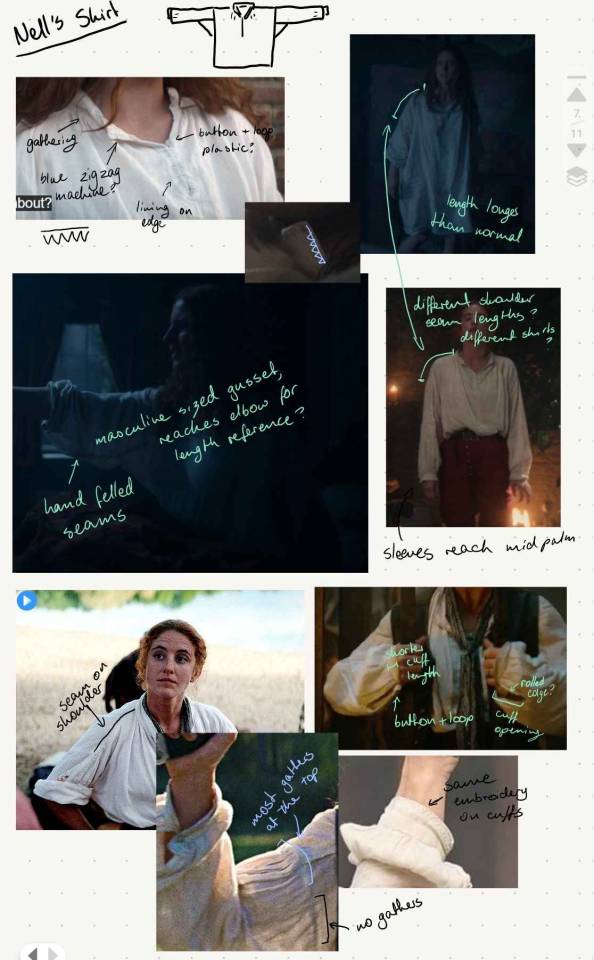
Above is my collection of screenshots (and gifs u can find if you search #sewing reference on my blog) from a rewatch of the show, with notes about construction details. I am so sorry about my handwriting, but if anyone is curious about anything they can't read please ask and I will happily provide.
The rundown though, is that it's a classic 18th century men's shirt, which you can find countless tutorials for if you want to make one that isn't so specifically Nell's.
There are a number of key details to note that are specific to this shirt however. The sizing of the shirt is a bit abnormal to the brief research I've done, with Nell's gussets (the triangle under the arm that allows movement) being a bit larger than what's to be expected, as well as the length being extremely long compared to other men's shirts. Eg:

(Credit indigomood for the gif, my phone couldn't handle searching for it in gifs so I had to download it)
Which, would make sense for a shirt she's taken from her late husband, but the sleeves are so fitted perfectly to her arm length, that I'm gonna just chalk these up as a mix of design choices for the comfort of Lousia when filming and giving the illusion of an oversized shirt.
Also, the cuffs and collar have a simple embroidery edging to them which I love. They have most likely been done on a modern machine, but we can cut Tom Pye some slack with the rest of the amazing work he's done. It looks like a zigzag stitch, with a straight stitch running on the side closest to the edge.
Also also, if anyone has seen Bernadette Banners pirate shirt tutorial, the sleeves and collar have less fabric and as a result less gathering. It's also mostly situated at the very tops of the shoulder, rather than all around the arms eye.
Alrightly onto the pattern drafting:
The Pattern:
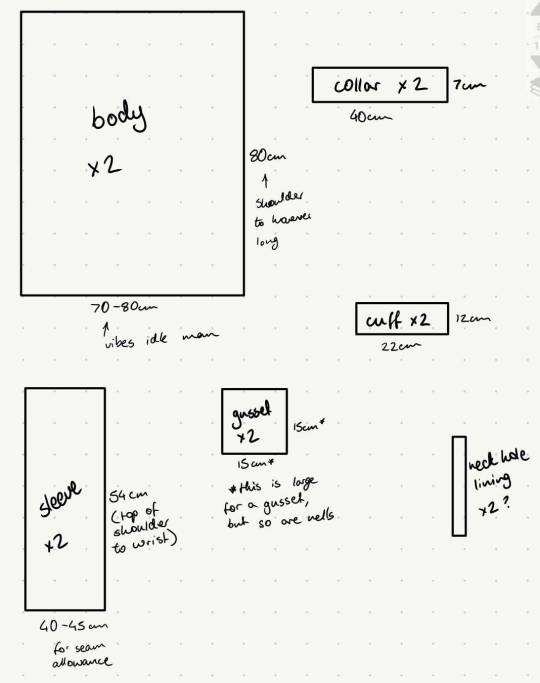

The first image is a not-to-scale sketch up of all the pattern pieces, with my estimation of measurements (with about 1cm seam allowance idk I learnt to sew without a sewing machine and this project isn't very fussy) for each piece, as well as some short notes for how I got some of the measurements. The second image is just a guide/plan of how to lay each piece out on my fabric with minimal waste, and will be different for each person if yall attempt this.
I'm ngl, I snatched Bernadette's pattern as a base, cause I've made that shirt before. The measurements also are a weird mix of the guides given in Bernadette's video, a great informative comment on the video by musikkfreaken342, and a general taking measurements of my own body (which is a similar body type to Nell's) and seeing how they compare to the photo references. I wish I could give more guidance here but I'm ngl I went based on vibes for most of this.
*Note: despite how long Nell's shirt appears to be in that Billy intro scene, I'm going to run on the assumption that the length was for actor comfort, and will be cutting mine shorter.
Also, ignore the neck slit lining/reinforcement for now. Idk how I'm doing that yet... so yeah.
Alright!! Moving onto actually cutting out the fabric!
Cutting the Fabric:
Historically these shirts are made from linen (and sometimes cotton I think?). Great material: looks great, breaths easy, whips sweat away from the skin to protect your outer layers.
I've personally chosen a lightweight linen/rayon blend, cause it's soft and I don't have the money for full linen. Def recommend a lightweight linen if possible for these shirts, it just works out nicer and comfier.
However, with linen comes the challenges of cutting everything out straight. As you may have noticed, all our pattern pieces are rectangles, and it's very important to cut these as straight as possible for the shirt to drape properly. As such, I've used a method called drawing threads, where you pull one thread out to make a guide to cut along.
You can skip the next few photos if you are not actually interested in sewing techniques and just want to see Nell's shirt.
First measure your piece. I've placed pins in where I want to cut.
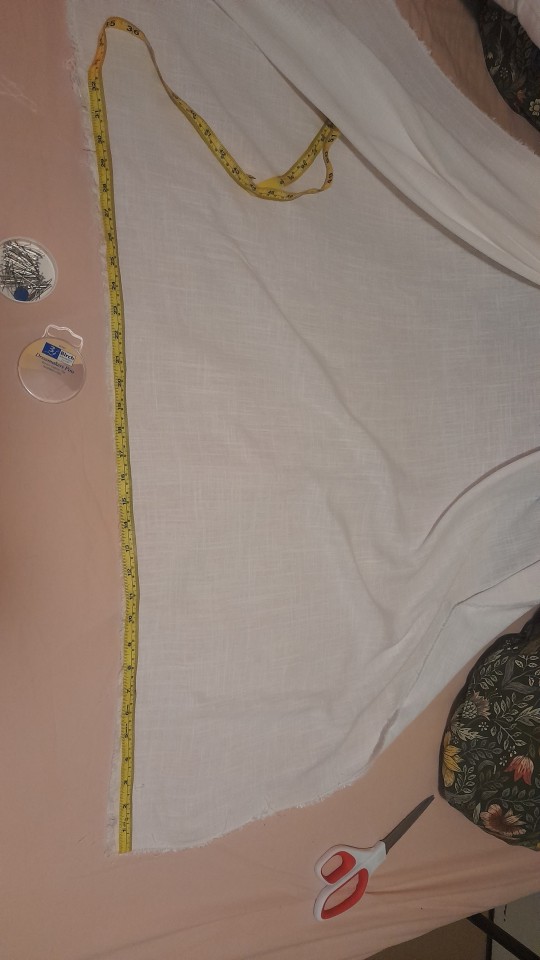
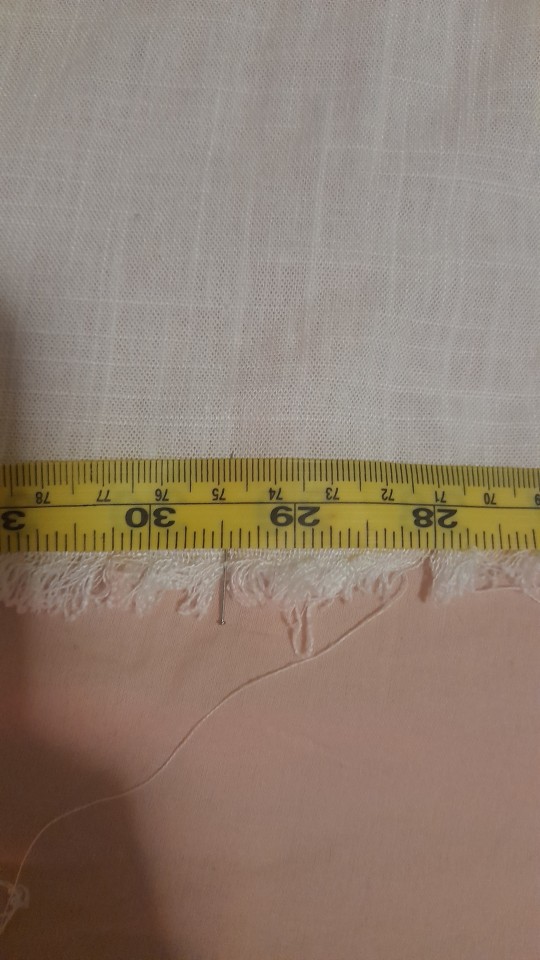
From there, I have cut a little notch, and separated out a thread.
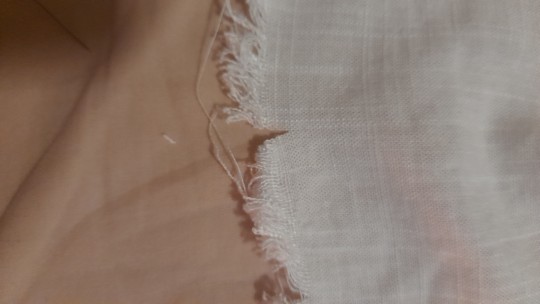
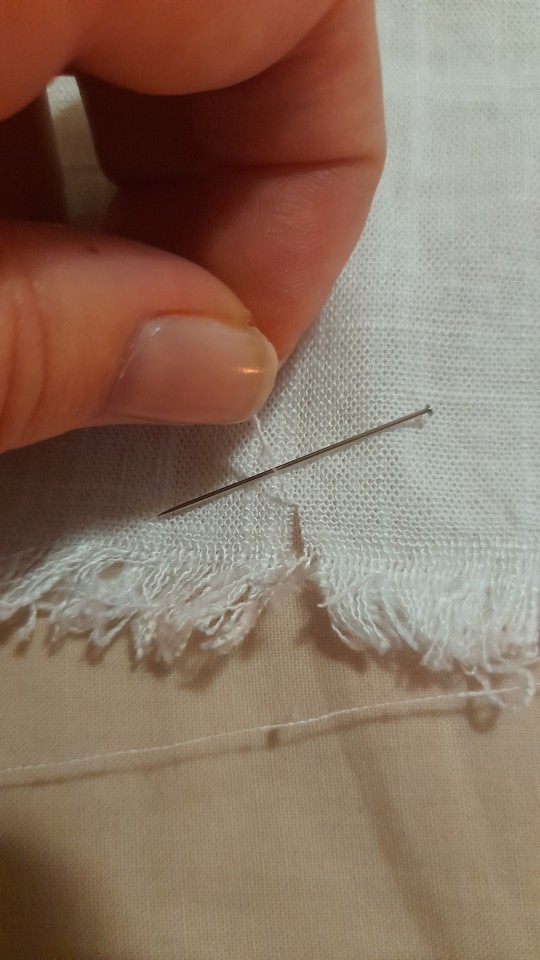
Here comes the tedious task of pulling on the thread until you end up with a gap in the weave! The thread will break on you countless times and you have to be patient I'm so sorry.
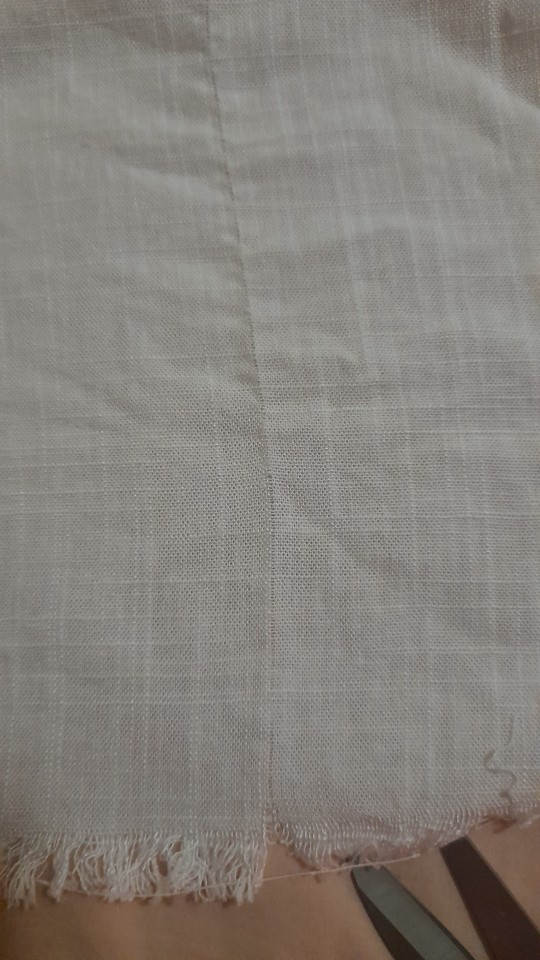
You then cut along that line to end up with perfectly rectangular pieces. I also recommend doing each piece either individually or in small groups.
Okay end of needless tutorial about cutting linen!!!
At the end of this whole process, I've ended up with all my pieces :D
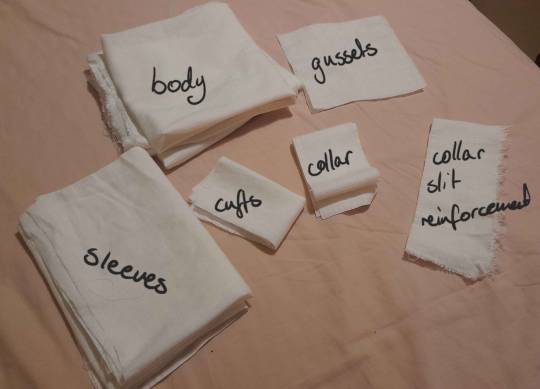
The collar slit reinforcement piece is just a scrap piece of fabric rn. Like I said idk what I'm doing for that yet.
Thats what I have for now! I'm lowkey planning on sewing most of this by hand, cause I'm that sort of person, so it might be a moment before I have a substantial update for if anyone is actually a fraction of the interested in this as I am sjfjskf.
#if anyone gets to the bottom of this post ilysm#nell jackson#costume recreation#renegade nell#sewing#cosplay
36 notes
·
View notes
Text
Official Promo Hoodie

Detailed Pictures Courtesy of @arth-ur


The most popular fandom recreation, Jack Frost's iconic blue hoodie, did have an official version during the movie's premier showing.




The hoodie is a dark blue with white zipper and drawstrings and light blue frost print on the pocket, collar, elbows, and wrist areas. Heather is a type of fabric where grey material is woven with another color, this gives the official hoodie a grey look in most photos you will find of it.

The frost pattern is printed unevenly along the collar, as the hoodies were not made custom but printed onto the American Apparel F497 zip-hoodie. The current (2024) F497 available is a 50/50 polyester cotton while the 2012 hoodie was a tri-blend of cotton, polyester, and rayon. This is important when identifying well made reprints of the hoodie.




The most notable frost pattern will be the logo on the right arm sleeve, the Rise of the Guardians title will be below and to the right of the frost pattern, not directly below or inside it.



There is also photos online of hoodies with black draw strings, I currently have no information on this variant.

I do not currently have a price range on this as it rarely shows up online under the tags and the ones that do vary wildly in price. I would personally price it at above $50 at the lowest, however the Fandom recreations are often lovingly crafted and depending on quality and if its embroidered, bedazzled, or covered in glitter, can go for above $100. A Jack Frost cosplay with staff was just posted (Oct 2nd 2024) on Mercari for $60 and was sold within the hour.
#rotg merch#rotg collection#rotg price catalog#rise of the guardians#rotg#hoodie#clothing#american apparel
16 notes
·
View notes
Text
i recently found an almost exact alternative to the purple lace pullover that violet wears!
it’s from the brand dolled up.

here’s the links to some i found on ebay in a few different sizes and colours! there is already a purple colourway already though which is great!
#american horror story#violet harmon#tate langdon#ahs murder house#ahsedit#ahs#ahsfx#tate and violet#murder house#violet harmon clothes#violet harmon s1#violet harmon exact#violet harmon x tate langdon#violet harmon edit#violet harmon fashion#violet harmon style#ahs violet#violet and tate#violet harmon aesthetic#violet harmon exacts#violet harmon ahs#ahs season 1#tate ahs#ahs s1#ahs fandom#american horror story murder house#american horror story s1#american horror murder house#tate langdon exacts#tate langdon edit
17 notes
·
View notes
Text
One of my typical online fabric resources sent me an email basically saying that due to the closure of a "large fabric retailer" there are some shipping delays.
I've seen some compilations of resources going around for fiber art materials, so here's mine.
*Check to see what indie sellers your city/county has already. You might be surprised. I get a lot of my favorite stuff at my local indie.
*Thrift stores! Some will have craft/sewing supply sections. Home textiles are a treasure trove of usable fabrics as well. There are even some art/craft supply resellers. Again, a quick online search could be very illuminating.
*Indie stores out of your area. Most of those shops do online ordering too! If you find one on IG or something that's too far to drive to, you can probably order through their website.
*Online shopping from bigger stores is still an option too. Here are a few of my favorites:
Fabric Wholesale Direct: broad selection for general garment and craft sewing. A good selection of cottons in a battery of weights and weaves, a lot of rayon, and tons of synthetic fabrics if you're into that.
Linen Lab: shipping directly from Korea, this company specializes in linen (obviously) but they also have cotton, hemp, and even ramie at very decent prices. Some of their fabrics are also dead stock, which is very cool and they send you a bunch of swatches for like $15, which is also cool.
Fabrics-Store: also primarily a linen seller, they have rotating daily deals and if you sign up for their emails, you can get the occasional special discount. Is it the best quality linen ever? No, though their "signature finish" line is rather nice. But it's still linen, which is superior in every way for hot weather. And I've never found it to be too wrinkly like some linens.
Dharma Trading Co: this is a fabric dye company that also sells nice fabrics to dye. That means almost everything is white. That being said, I've been dying (ha) to get some of their wool/silk blend for historically inspired under layers. They also have hemp and linen-- all competitively priced. And if you don't want it to stay white, they have you covered there too.
Honestly, that's about it for me. Pretty much everything I've made over the last five years, now about half my wardrobe plus some historical costumes, has come from the above sources. I am not a silk girl-- you have to hit up the 18th century enthusiasts for that. But these are where I get all my comfy fabrics that I wear day in and day out along with some favorite looking stuff too.
Most yardage purchased is probably my local indie in first place, Fabrics-Store in second because I love working with linen and they used to have crazy sales back a few years ago.
4 notes
·
View notes
Note
I would really like to learn to crochet or knit, but I'm allergic to both wool and acrylic. Are there good options for this using cotton or other fabric yarn?
Oh, tons!
Lily's Sugar & Cream is a great yarn to start with. 100% cotton, and available basically anywhere. It's generally used for "housewares" sort of projects, but you can use it for anything really. The link up there will get you to the brand website, which will have a bunch of free patterns to check out.
Knitpicks has a lot of options with cotton. Some of these ARE cotton/acrylic, so double check labels. I really like Dishie (their answer to Lily's), and I'm currently working with Cotlin (a cotton/linen blend) for a big project. They've also got stuff made with beech fiber and bamboo, which I can tell you from experience holds up very well. Knitpicks is online only, but I've used them for years and recommend them highly.
Lion Brand has some good cottons and cotton blends. I really like Coboo, which is super soft. I also just got some Truboo for making a sweater. It's rayon made from bamboo. Lion Brand, like Lily's, is available basically everywhere you might have nearby.
Bamboo, cotton, and linen are all pretty easy to find, either alone or combined. There's also a bunch of other animal fibers like alpaca or angora you can get your hands on, though they'll be pricier.
Anyway, lots of options to get you started!
16 notes
·
View notes
Text

US Vogue May 1, 1956
Anne St. Marie wears a high-waisted evening ensemble, coral bodice and faux-linen cotton and rayon-blend coat from Avisco; skirt in silky white cotton with coral polka dots (both of these Fuller fabrics). By Claire McCardell. Earrings: Lilly Dache. Lipstick "5" John Robert Powers.
Anne St. Marie porte un ensemble de soirée taille haute, corsage corail et manteau en coton imitation lin et mélange de rayonne Avisco ; jupe en coton soyeux blanc à pois corail (ces deux tissus Fuller). Par Claire McCardell. Boucles d'oreilles : Lilly Dache. Rouge à lèvres "5" John Robert Powers.
Photo Irving Penn vogue archive
#us vogue#may 1959#fashion 50s#spring/summer#printemps/été#claire mccardell#lilly daché#anne st.marie#irving penn#john robert powers#avisco#fuller fabric#vintage vogue#vintage fashion
15 notes
·
View notes
Text
Chic and Comfortable: The Best Casual Boutique Dresses for Every Occasion

In today’s world of fast fashion, finding a wardrobe that feels truly unique and personal is becoming more and more challenging. That’s where boutique clothing shines—offering pieces that combine quality, style, and comfort. When it comes to finding the perfect balance between chic and comfortable, casual boutique dresses are a game-changer. These dresses are made from high-quality fabrics, come in a variety of flattering cuts, and often feature unique designs that help you stand out. Whether you're running errands, meeting friends for lunch, or enjoying a weekend getaway, the right casual boutique dress can offer both style and ease, ensuring that you feel as good as you look.
In this blog post, we’re going to dive into some of the best casual boutique dresses that can take you through every occasion with flair and comfort. From simple day-to-day looks to something a little more polished for those semi-casual events, we’ll break down the options that will suit your lifestyle and elevate your wardrobe.
1. The Effortless Midi Dress
The midi dress is a timeless staple that strikes the perfect balance between comfort and sophistication. Falling just below the knee or mid-calf, this style flatters nearly every body shape and can be dressed up or down depending on the occasion. The beauty of a midi dress is in its versatility. For a casual, day-to-day look, go for a simple, solid-colored midi in a soft, breathable fabric like cotton or linen. These materials are not only lightweight and comfortable but also keep you cool in warmer months.
Pair a solid midi dress with sneakers or flat sandals for a chic yet relaxed vibe. For cooler days, you can throw on a denim jacket or a cardigan for an added layer of comfort without compromising style. Want to elevate the look? Swap in a pair of ankle boots and layer a structured blazer on top, and suddenly your midi dress transforms into a smart-casual outfit perfect for lunch meetings or evening events.
2. The Classic Shirt Dress
If you're looking for a dress that combines timeless appeal with practicality, the shirt dress is your go-to. This classic style draws inspiration from a button-up shirt but with the added flair of a full dress. With its structured collar, button-down front, and usually, a relaxed fit, the shirt dress is ideal for a look that is both chic and comfortable.
Casual boutique shirt dresses come in various styles, from the oversized silhouette to more tailored versions that cinch at the waist with a belt. For a laid-back look, opt for a simple shirt dress in soft fabrics like chambray, cotton, or a blend of both. Pair it with comfortable sneakers or loafers for a practical yet stylish ensemble, perfect for running errands or casual coffee dates. If you're looking to elevate it for something like a weekend brunch, add a leather jacket or a scarf for extra flair.
3. The Relaxed Maxi Dress
Maxi dresses are often associated with warmer weather, and for good reason. They offer a relaxed, free-spirited vibe while also being incredibly comfortable. A casual boutique maxi dress typically features flowy, breathable fabrics such as jersey, cotton, or rayon, making them perfect for everything from beach days to weekend outings.
One of the things that makes the maxi dress so desirable is its versatility. You can go for a bohemian style with a floral pattern or opt for something more streamlined and minimalist in solid colors like navy or black. A maxi dress with a deep V-neck or off-shoulder neckline is great for a beach trip, while a more structured maxi dress with a belted waist can easily transition to a casual dinner with friends. Pair your maxi dress with sandals or espadrilles, and you’ll look effortlessly chic with little effort involved.
4. The Cozy Sweater Dress
As the seasons change and the weather gets chillier, the sweater dress becomes an essential piece for any wardrobe. Casual boutique sweater dresses are made with comfort in mind, offering soft, knitted fabrics that keep you warm without sacrificing style. Sweater dresses come in a variety of fits—some are more form-fitting, while others have an oversized, slouchy appeal.
For a cozy but chic look, opt for a midi-length sweater dress in a neutral color like gray, beige, or cream. These shades are not only versatile but also add an element of sophistication. You can easily pair a sweater dress with tights and ankle boots for a classic winter look, or opt for knee-high boots for a bit of extra warmth. Add a long cardigan or a wool coat, and you’re set for everything from casual office days to weekend outings.
5. The Simple T-Shirt Dress
If you're all about minimalism and comfort, the t-shirt dress is your best friend. It combines the ease of your favorite tee with the style of a dress, making it the ultimate go-to for those days when you want to look put together with zero fuss. The beauty of boutique t-shirt dresses is that they are often made from higher-quality fabrics that feel soft against the skin and fit beautifully.
A casual boutique t-shirt dress is incredibly versatile—whether it’s a classic oversized fit or a more tailored silhouette, you can style it in multiple ways. Pair it with white sneakers for a laid-back weekend vibe, or throw on a denim jacket and some ankle boots to make it more polished for brunch or a day at the park. T-shirt dresses also offer endless opportunities for accessorizing—think oversized sunglasses, layered necklaces, or a chic hat to make the look your own.
6. The Feminine Wrap Dress
For a touch of elegance with your everyday wardrobe, the wrap dress is a must-have. The beauty of a wrap dress lies in its universally flattering shape. It draws attention to your waistline while allowing for a flowy, comfortable fit that can be dressed up or down. Casual boutique wrap dresses often come in lightweight materials such as cotton, jersey, or even a soft rayon blend, ensuring that comfort is never sacrificed for style.
A wrap dress is perfect for everything from casual office wear to a laid-back afternoon picnic. Pair it with wedges or block heels for a more polished look, or opt for sandals for a more relaxed vibe. For those cooler days, layer a denim jacket or a lightweight cardigan over the dress for added warmth. The wrap dress is one of those timeless pieces that will always make you feel chic, no matter the occasion.
7. The Playful A-Line Dress
The A-line dress is a classic silhouette that works for nearly every body shape. With its fitted bodice and gently flared skirt, it creates a flattering, feminine shape that’s comfortable and easy to wear. Casual boutique A-line dresses often feature fun patterns, delicate details, or unique cuts that make them stand out from your average high-street dress.
You can wear an A-line dress for a wide variety of occasions, from a lunch date with friends to a casual day at the office. Go for a simple, solid-colored A-line dress for versatility, or opt for a floral or striped design to add a little personality. Pair it with sneakers for a more relaxed look, or with ballet flats or sandals for an easygoing style that still looks put together.
8. The Boho-Inspired Dress
If your style leans more toward bohemian vibes, then a boho-inspired boutique dress is just what you need. These dresses often feature flowy fabrics, bell sleeves, and earthy prints that create an effortlessly chic look. Whether it’s a loose-fitting tunic dress or a more structured version with intricate embroidery, boho dresses are all about comfort and individuality.
Perfect for music festivals, casual weekends, or beach days, a boho-inspired dress pairs wonderfully with strappy sandals, a wide-brimmed hat, and some layered jewelry. These dresses embrace a carefree attitude while making you feel stylish and comfortable all day long.
Conclusion
Finding the right casual boutique dress for every occasion doesn’t have to be difficult. The key is to look for pieces that blend style, comfort, and versatility. From timeless midi dresses to cozy sweater dresses, the options are endless, and the best part is that these boutique dresses can effortlessly transition from one event to the next. Whether you’re lounging at home, enjoying a casual dinner, or heading out for a day of adventure, you’ll always feel chic, confident, and comfortable in a well-chosen casual boutique dress.
So, next time you’re shopping for that perfect dress, keep in mind the balance between comfort and style—because the best casual boutique dresses truly offer both, making your day-to-day wardrobe more enjoyable, fashionable, and stress-free.
2 notes
·
View notes
Text
Are you looking to shop more sustainably? One way is to buy clothing that has natural fibers. Plastics in clothing is one of the main contributors to microplastics. So what to look for?
Polyester, elastin, and poly-blends are all plastic based fibers. Similarly, if you buy wool avoid Angelina. That's just Easter grass mixed in to give shimmer.
More sustainable fabrics are: cotton, linen, wool, cashmere, leather, rayon and hemp. Bamboo is a more sustainable rayon than other types. Some leathers have a lot of toxic chemicals in the processing but leather lasts and you'll produce less waste overall.
Avoid vegan leather. Unless it's mushroom based, that's just plastic. Get cotton shoes like converse.
It may cost a little more, but it's worth it for yourself and the planet.
20 notes
·
View notes
Text
How to Style Traditional Kurtis for Daily Wear
Traditional kurtis have become a staple in every Indian woman’s wardrobe, blending comfort with style effortlessly. Whether you are heading to work, running errands, or catching up with friends, kurtis offer versatility and elegance. If you are looking to shop for traditional kurtis online, here’s a guide to help you style them for daily wear while keeping your look fresh and trendy.
1. Pair with the Right Bottoms
Leggings: The classic combination of kurtis with leggings is ideal for a clean and polished look. Choose contrasting colors to make your outfit pop.
Palazzos: Wide-legged palazzos add a contemporary touch to your traditional kurti. Opt for printed palazzos with plain kurtis or vice versa.
Jeans: For a casual, Indo-western vibe, pair your kurti with slim-fit jeans. This is perfect for college or casual outings.
Skirts: Flowy skirts paired with kurtis can give you a boho-chic appearance. Experiment with asymmetrical kurtis for a modern twist.
2. Layer It Up
Add a denim jacket or a lightweight shrug over your kurti for a stylish, layered look.
Dupattas are a timeless addition. Choose light cotton or chiffon dupattas for daily wear and experiment with prints and patterns.
For cooler days, pair your kurti with a long cardigan or a stylish stole.
3. Accessorize Smartly
Jewelry: Jhumkas, stud earrings, or simple silver bangles can elevate your look without being over the top.
Footwear: Juttis or mojaris complement traditional kurtis perfectly. You can also opt for comfortable flats or kolhapuri chappals for daily wear.
Bags: Sling bags or totes in earthy tones pair well with traditional kurtis, adding functionality and style.
4. Choose the Right Fabric
For daily wear, go for breathable fabrics like cotton, linen, or rayon. These materials keep you comfortable and allow for easy movement.
During winters, opt for kurtis in wool blends or thicker cotton for added warmth.
5. Experiment with Prints and Colors
Block prints, florals, and paisley patterns are evergreen choices for daily wear.
Neutral shades like beige, white, and pastel tones work well for a subtle look, while vibrant colors like red, mustard, or green can brighten up your day.
6. Opt for Comfortable Cuts
A-line kurtis and straight-cut kurtis are perfect for everyday wear as they provide a comfortable fit.
High-low hemline kurtis or side-slit designs add a modern flair without compromising on comfort.
7. Mix and Match for Variety
Pair plain kurtis with printed or embroidered bottoms for a fresh look.
Use colorful scarves or belts to cinch your waist and add a trendy touch.
Why Shop for Traditional Kurtis Online?
Shopping for traditional kurtis online offers a vast array of choices, from different styles and patterns to a variety of fabrics and colors. Online platforms provide the convenience of browsing through the latest trends, comparing prices, and finding kurtis that suit your daily wear needs. Additionally, you can find exclusive deals and discounts, making it a cost-effective way to update your wardrobe.
Final Thoughts
Styling traditional kurtis for daily wear doesn’t have to be complicated. With the right combinations and a little creativity, you can make a simple kurti look stylish and chic. Remember, comfort is key when it comes to daily wear, so choose outfits that reflect your personal style and make you feel confident. Explore the latest collections of traditional kurtis online and give your wardrobe a delightful update!
2 notes
·
View notes
Text
Dear Diary…
Today I am wearing *real* jeans for the first time in years.
Not leggings. Not joggers. Not nylon or rayon or polyester. Not skinny “jeans” with fabric blends that give them lots of stretch.
They aren’t sized small, medium, or large. They aren’t even sized 8, 10, or 12.
Today, I’m wearing jeans made out of 100% cotton, sized by the inches of my waist. Like God and Levi Strauss intended.
I have evolved.
5 notes
·
View notes